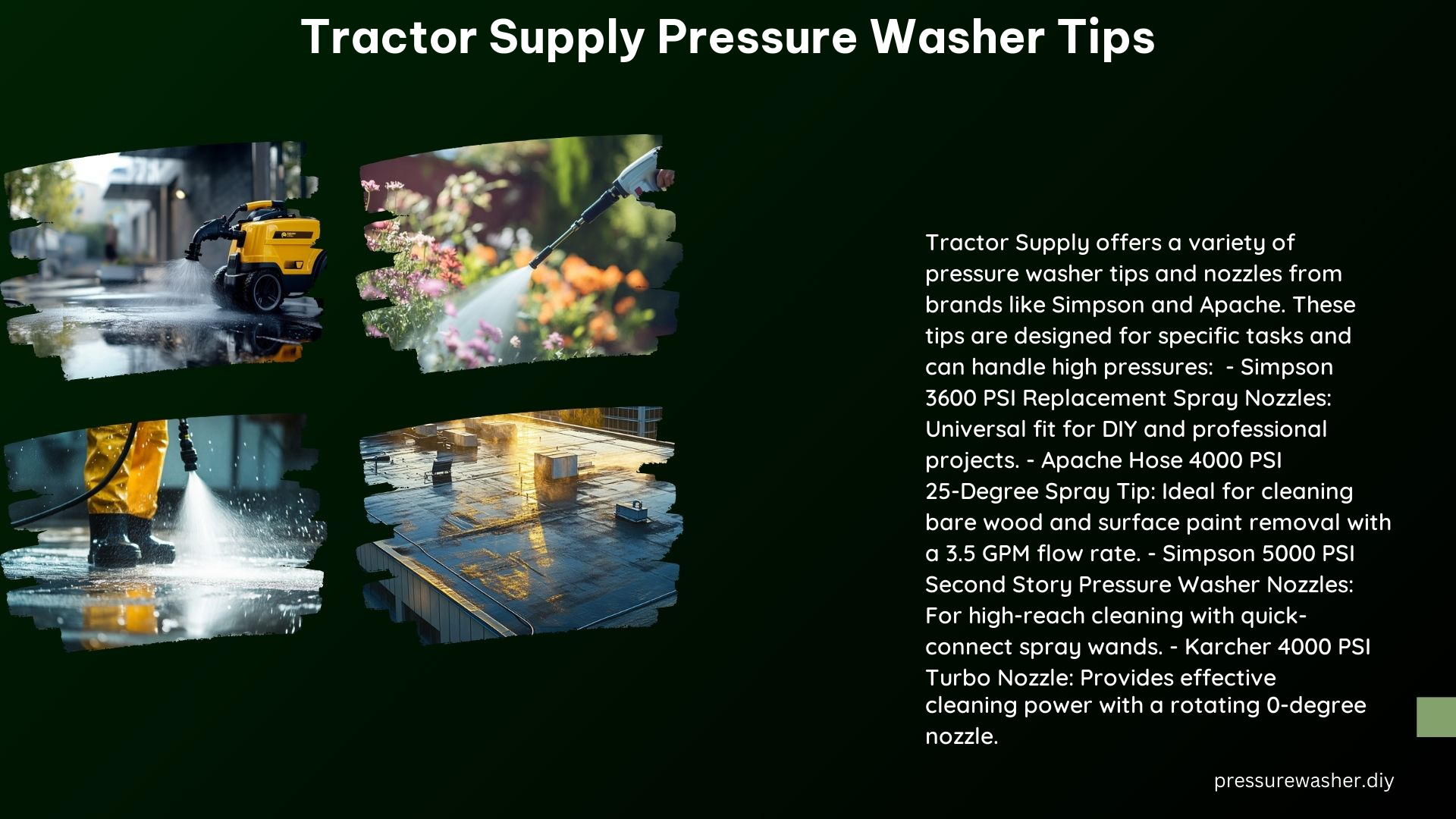Tractor Supply offers a wide range of pressure washers and accessories from trusted brands like Simpson and Karcher, catering to various cleaning needs. Whether you’re tackling a residential project or an industrial-scale task, this comprehensive guide will provide you with the necessary tips and technical details to choose the right pressure washer and use it safely.
Choosing the Right Pressure Washer
Pressure (PSI) and Flow Rate (GPM)
The pressure (PSI) and flow rate (GPM) of a pressure washer are crucial factors to consider when selecting the right model for your needs. For residential use, the Simpson 3300 PSI at 2.4 GPM Honda GCV200 is a suitable choice, providing ample power for tasks like cleaning decks, siding, and vehicles. On the other hand, the Simpson 4200 PSI 4 GPM Gas Cold Water PowerShot is better suited for industrial-scale applications, such as heavy-duty equipment cleaning or surface preparation.
Engine Type: Gas vs. Electric
Tractor Supply offers both gas-powered and electric pressure washers, each with its own advantages. Gas-powered models, like the Simpson 2800 PSI 2.3 GPM MegaShot, are generally more powerful and can handle tougher cleaning jobs. They are ideal for large outdoor areas or projects that require extended runtime. Electric pressure washers, on the other hand, are quieter, more environmentally friendly, and better suited for indoor use or smaller tasks.
Accessories and Nozzles
The right accessories and nozzles can significantly enhance the performance and versatility of your pressure washer. The Simpson Replacement Spray Nozzles, rated up to 3,600 PSI, are universal and can be used for a variety of cleaning tasks, from deck cleaning to surface preparation. For specialized applications, the Apache Hose 4000 PSI 25-Degree Pressure Washer Spray Tip is ideal for cleaning bare wood and removing surface paint.
Safety Tips

Protective Gear
Safety should always be the top priority when operating a pressure washer. Wearing the appropriate protective gear, such as safety glasses, gloves, and closed-toe shoes, is essential to safeguard yourself from debris and high-pressure water streams.
Maintaining a Safe Distance
Keeping a safe distance from the spray nozzle is crucial to avoid injury from the powerful water stream. Refer to the manufacturer’s recommendations for the optimal distance to maintain during operation.
Choosing the Correct Nozzle
Using the right nozzle for the task at hand is vital to avoid damaging surfaces or causing injury. Consult the pressure washer’s manual or seek guidance from Tractor Supply associates to ensure you select the appropriate nozzle for your specific cleaning needs.
Starting with Low Pressure
Begin your cleaning tasks with a low-pressure setting and gradually increase the pressure as needed. This approach helps prevent damage to delicate surfaces and ensures a controlled and effective cleaning process.
Avoiding Electrical Hazards
Keep the pressure washer away from electrical outlets and avoid using it in wet conditions to minimize the risk of electrical shock. Maintain a safe distance from any electrical sources during operation.
Technical Specifications
Simpson 3300 PSI at 2.4 GPM Honda GCV200
- Pressure (PSI): 3300
- Flow Rate (GPM): 2.4
- Engine: Honda GCV200
- Price: $399.99 (20% off from $499.99)
Simpson 4200 PSI 4 GPM Gas Cold Water PowerShot
- Pressure (PSI): 4200
- Flow Rate (GPM): 4
- Engine: Honda GX390
- Price: $1,199.99
Apache Hose 4000 PSI 25-Degree Pressure Washer Spray Tip
- Pressure (PSI): 4000
- Flow Rate (GPM): 3.5
- Price: $39.99
Reference Links
- Simpson Replacement Spray Nozzles
- Tractor Supply Pressure Washers and Accessories
- Karcher Turbo Nozzle
- Apache Hose 25-Degree Pressure Washer Spray Tip
By following these Tractor Supply Pressure Washer Tips, you can confidently select the right pressure washer for your needs and use it safely to tackle a wide range of cleaning tasks, from residential projects to industrial-scale applications.
